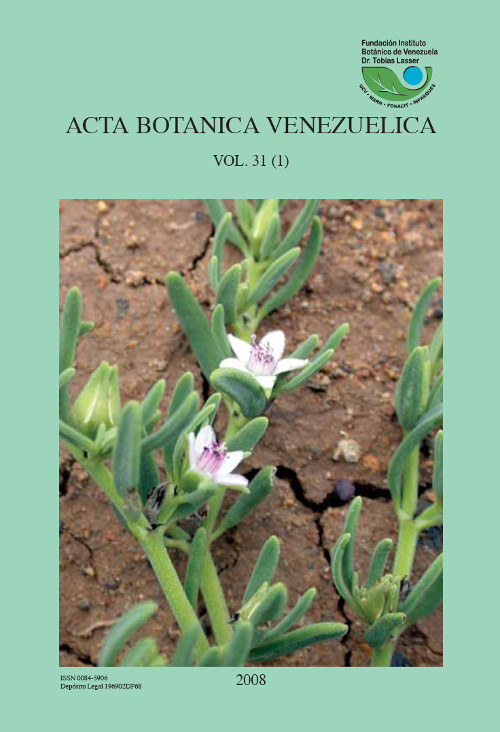ASPECTOS ESTRUCTURALES Y FLORÍSTICOS DE CUATRO BOSQUES RIBEREÑOS DE LACUENCADELRÍO AROA, ESTADO YARACUY, VENEZUELA
Resumen
RESUMEN
Se caracterizaron aspectos de la composicion floristica y de la estructura de cuatro bosquesriberenos de la cuenca del rio Aroa, zona vecina del Parque Nacional Yurubi en la serraniade Aroa perteneciente a la cordillera de la costa en el occidente de Venezuela, con el propositode resaltar la importancia de estos bosques para conservar la biodiversidad. Enparcelas de 0,1 ha se censaron los individuos con DAP . 2,5 cm. Se muestrearon 789 individuos,distribuidos en 38 familias, 78 generos y 94 especies. De los individuos registrados,40% pertenecen a las familias Euphorbiaceae (96), Piperaceae (53), Annonaceae (38), Mimosaceae(32), Lecythidaceae (31), Myristicaceae (28), Lacistemataceae (23) y Araliaceae(19). La familia con mayor riqueza de especies fue Rubiaceae (10), seguida por Euphorbiaceae(7), Mimosaceae (7), Caesalpiniaceae (4), Myristicaceae (4), y Araliaceae y Annonaceae(3). Los bosques riberenos estudiados presentaron dominancia heterogenea compartida entreaproximadamente seis especies, excepto el bosque ribereno del rio Carabobo, sector El Tigre,que presento marcada dominancia del candelo (Gyranthera caribensis), con 19% del Indicede Valor de Importancia (IVI). Las caracteristicas estructurales de las parcelas estudiadas revelanque estos cuatro bosques riberenos tienen un dosel conformado en su mayoria por individuosque pueden alcanzar 8 m de altura y donde predominan las clases diametricas comprendidasentre 2,54-10 cm de DAP, a excepcion del bosque ribereno del rio Carabobo, sectorEl Tigre donde 49% de los individuos pertenecen a clases diametricas . 10 cm de DAP y 52%de los individuos tienen alturas . 8 m.
ABSTRACT
Four riparian forests of the basin of the Aroa river neighboring area of the Yuribi NationalPark in the Aroa mountainous region were studied in western Venezuela, on the purposeof showing the importance of forests in biodiversity conservation. Quantitative datawere recorded on the floristic composition, structure and diversity of four 0.1 ha plots. Allthe individuals with DBH . 2.5 cm were recorded. In this study 789 individuals, 94 species,78 genera and 38 families of vascular plants were sampled. Among the registered individuals, 40% belong to the families Euphorbiaceae (96 individuals), Piperaceae (53), Annonaceae(38), Mimosaceae (32), Lecythidaceae (31), Myristicaceae (28), Lacistemataceae(23) and Araliaceae (19). The family with the highest number of species was Rubiaceae(10), followed by Euphorbiaceae (7), Mimosaceae (7), Caesalpiniaceae (4), Myristicaceae(4), Araliaceae and Moraceae (3). The riparian forests studied showed an heterogeneous dominanceof at least six species, although the riparian forest El Tigre showed a strong dominanceof candelo (Gyranthera caribensis) with 19% of Importance Value Index (IVI). Thestructural characteristics of the studied plots reveal that these riparian forests present a canopythat can reach 8 m of height and that the diametric classes between 2.5 and 10 cm ofDBH prevail. However, 49% of the individuals from the riparian forest El Tigre belong todiameter class ≥ 10 cm of DBH and 52% have heights ≥ 8 m
Descargas
Descargas
Número
Sección
Licencia
© Instituto Experimental Jardín Botánico "Dr. Tobías Lasser" |


